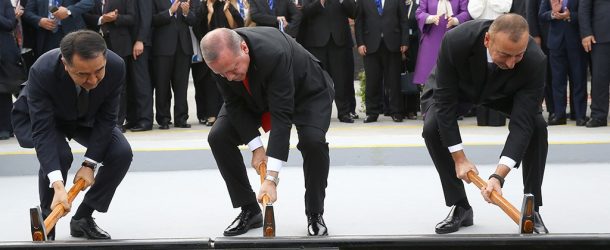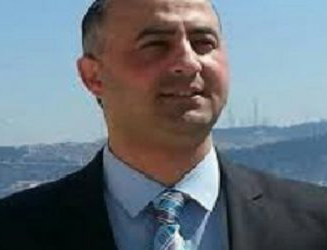Though the initial idea about the Baku-Tbilisi-Kars (BTK) railway project was raised in the early 1990s, it was not taken seriously due to regional instability and economic difficulties. However, with the realization of the Baku-Tbilisi-Ceyhan oil and the Baku-Tbilisi-Erzurum gas pipelines in 2006, the idea of a railway connection became real once again.
The BTK, covering 850 km with a capacity of 5 million tons of cargo (upgradable to 15 million) per year and one million passengers (upgradable to three million), and connecting Azerbaijan, Georgia and Turkey, was launched in 2007 (Klimas and Humbatov, 2016:38; Uysal, 20 October 2014).It was launched without any international backing mainly because Armenia was left out due its occupation of nearly 20 percent of Azerbaijani territory after a war in the early 1990s that ended in a cease-fire in May 1994.
Though initially the plan was to be completed in 2010, financial challenges as a result of falling oil prices meant that it became operational only on 30 October 2017. Azerbaijan was the driving force behind the BTK railway project. The BTK is an important step in reviving the historical Silk Road. The Silk Road refers to an ancient network of trade routes that was used from 130 BC, when Han China opened trade with the West, to 1453 AD when the Ottoman Empire decided to end trade with the West and closed the routes. However, the term is far more recent. It was coined by the German geographer and traveler, Ferdinand von Richthofen, in 1877 AD, who designated this network of trade routes ‘Seidenstrasse’ (silk road) or ‘Seidenstrassen’ (silk routes) (Mark, 28 March 2014).
However, the trade routes carried far more than silk. Trade included textiles, spices, grain, vegetables and fruit, animal hides, tools, wood work, metal work, religious objects, art work, precious stones and a lot more. It carried ideas and people too (UNESCO, nd.). Ideas and culture were transmitted changing the face of Eurasia. Many of the cities along the Silk Road became hubs of culture and learning. It connected the Han Chinese Empire with the Roman Empire. Starting at Xi’an (Sian), the 4,000-mile (6,400-km) road, in reality a caravan tract, followed the Great Wall of China to the northwest, bypassed the TaklaMakan Desert, climbed the Pamirs (mountains), crossed Afghanistan, and went on to the Levant; from there the merchandise was shipped across the Mediterranean Sea. Not many merchants travelled the entire route. In fact, the trade was handled by a series of middle men (Encyclopedia Britannica, 30 October 2017).
With changing regional and geopolitical constellations, the historic Silk Road is on its way to revival, with a strong geo-political motive. In this respect, China’s Belt and Road Initiative (BRI), which plans to improve Chinese rail and sea transportation to better connect with the global economy, strengthens the future perspective of the BTK. The Belt and Road goes through 65 countries, includes 70% of the world’s population, three-quarters of its energy resources, a quarter of goods and services and 28% of global GDP – some $21 trillion (Campbell, 2017).
Hence, the importance of the project is manifold, ranging from economic to strategic interests. Being a part of traditional Silk Road route plays an important role for freight and passenger transportation between Asia and Europe. The BTK increases the strategic importance of Azerbaijan by enabling it to become a transport hub between Europe and Asia. Azerbaijan has already secured its energy independence thanks to the Baku-Tbilisi-Ceyhan and Baku-Tbilisi-Erzurum pipelines, both supported by the West and transnational oil companies such as BP and ExxonMobil. However, the same support could not be secured for the BTK railway project.
The BTK has faced serious challenges including a lack of support from international donors or Great Powers. Indeed, under pressure from the Armenian lobby, possible funding from the USA was blocked for the BTK (Tsurkov 13 November 2017).Thanks to the decisiveness of Azerbaijan, the biggest hurdle, thelack of finances to carry out the construction/reconstruction works in Georgia was solved with Azerbaijan’s offer of a loan of $775 million with concessional terms to Georgia (Klimas and Humbatov, 2016:22). It is important to note that the total cost of the BTK was above $1 billion. Thus, Azerbaijan indeed took the lion’s share of responsibility in realization of the BTK project. This showed how important a small state could be in big regional projects without international backing.
There are still many uncertainties ahead the entire Belt Road project. It passes through some of the world’s most volatile borders – Iran-Turkey, Russia-Ukraine, and the de-facto border between Western and Eastern Ukraine. China expects countries like Vietnam and Malaysia, with whom it competes for maritime influence to co-operate on the project. Another problem is that this ambitious attempt to connect the world’s richest regions in the West and the East through a swathe of poorer territory might mean that China has to extend geopolitical commitments, including military, which may not be welcome (Bohl, 2017).
In addition, the new Silk Road project has the potential of upsetting China’s regional rivals such as Japan and India. In an indication that such a challenge would be addressed Japan and India recently announced the AAGC (Asia Africa Growth Corridor) an initiative led by a partnership between India and Japan to better integrate the economies of South, Southeast, and East Asia with Oceania and Africa. In contrast to the land based routes of the New Silk Route this will be series of intersecting sea based economic triangles interconnecting cities in Central Asia which is expected to have rapid economic growth (Shepard, 2017a).
Such moves risk upsetting the traditional power in Central Asia-Russia – which as a legacy of the Tsarist and Soviet Empires has considerable influence in the region. Russia has cooperated with India on its own continent-crossing plan the North-South Transport Corridor (NSTC). This 7,200-kilometer multimodal trade corridor is expected to run from India to Russia, linking the Indian Ocean and Persian Gulf to the Caspian Sea, improving India’s connections to Iran, Russia, the Caucasus, and Central Asia (Shepard, 2017b).
A Russia, no longer under sanctions, could become a serious rival for the BTK. Additionally, China should fully commit to send goods to Europe mainly through the historic Silk Road route rather than through the Suez Canal (Twelves, 1 November 2017). Furthermore, so-called ‘frozen conflicts’ in the region should be taken into consideration. A possible restart of an armed conflict can put regional projects into danger. Therefore, in the long term, some grave challenges remain.
However, standing up to these challenges could open up new perspectives. In other words, with full-fledged commitment by China and regional countries and the solution of threatening ‘frozen conflicts’, the BTK has the potential to bring back the trade potential of the historic Silk Road and substantially contribute to the development of economies lying along the route.
The main significance of the BTK is that it will reduce Russia’s monopoly on overland transportation and boost the travel between Asia and Europe. Most importantly, the transportation cost and time will be reduced substantially. Being a piece of historic Silk Road, BTK will transport goods from China to Kazakhstan, and then through the Caspian Sea to Baku, from where it will be taken to Turkey via BTK and finally to Europe, as far as London. The time required for the trip will be around 13-15 days which is almost twice as fast as sea transportation to the same destination. Moreover, it is 50 percent cheaper than air transport (Rick, 1 November 2017; Klimas and Humbatov, 2016:11). China has been strengthening the Central Asian part of the historic Silk Road. In terms of trade turnover with the Central Asian countries, China already overtook Russia in 2008. In other words, China is Central Asia’s biggest trade partner. In 2013 China achieved a trade balance of $ 50 billion, whereas Russia had $31.5. Interestingly, in 2001 China’s trade with Central Asia was only $1.5 billion (Muzalevsky, 27 April 2016). In 2015, the Chinese president Xi Jinping mentioned that Chinese government aims at investing $46 billion in Central Asia in order to develop trade, transport and energy infrastructures (Muzalevsky, 27 April 2016). Until 2015 China have already invested nearly $40 billion to the Central Asian countries. Such a level of investment backs up the belief that Silk Road project is going to be revived in the coming few years. Benefiting from concessional loans from China and its own energy revenues, Kazakhstan have improved its transport infrastructure and build new railway connections which also includes the railway crossing the country from west to east.
Turkey is another country that eagerly supports the historic Silk Road expecting to become a transport hub between Asia and Europe. Apart from BTK, the famous Marmaray project is Turkey’s other contribution to the revival of historic Silk Road. The Marmaray project aims at connecting Europe and Asia by rail with a tunnel under the Bosphorus. This project, transporting both passengers and freight, is expected to be completed by February 2018 (Uysal, 4 July 2016).The BTK will be a crucial project to increase transport between Turkey and the CIS countries.
Initially Iran could lose out if the BTK project is realized as Turkey coulduse it to re-route goods that are currently transported to Iran via the CIS. However, in the long-run, if sanctions are liftedonce and for all, Iran will also benefit from the revival of historic Silk Road. Indeed, Iran has expressed its interest in building railway lines to Azerbaijan (Uysal, 20 October 2014).
Among others, the ministers of Kazakhstan, Uzbekistan, Tajikistan and Turkmenistan also attended the opening ceremony of the BTK railway in Baku (Mahmudov, 3 November 2017). This demonstrates the interests of all Central Asian countries to join the transportation route to transport their goods to the promising European market.
To conclude, the BTK will not only help the economies of Azerbaijan, Georgia and Turkey, it will also contribute to the trade between Asia and Europe bypassing Russia’s overland transportation monopoly. Therefore, it is not only an economical but also a strategic project. The major importance of the project is its positive impact on helping small countries to avoid Russian overland transport manipulations.
The BTK will increase both passenger and freight transportation between Asia and Europe outside Russian grip. It is the first regional non-energy project in South Caucasus connecting Azerbaijan, Georgia and Turkey. The BTK railway proved an alliance build around an infrastructure project involving small states can shape greater economic as well as political regional realities which impacts great players as well. Azerbaijan, taking the biggest responsibility for the completion of the BTK, will also take the lion’s share in terms of benefits. It will become a transport hub, if it further develops its transport infrastructures, and it will also get access better access to Europe by using the transportation infrastructures, e.g., ports of Turkey.
Previous energy projects have shaped the regional triangle between Azerbaijan-Georgia-Turkey, and BTK will further strengthen this network. BTK is a purely economic project. Yet, it certainly has political and cultural consequences as well; it can contribute to strengthening trust between nations. Historical mutual mistrust among the Chinese and Central Asians can be challenged with growing people-to-people encounters due to trade and travel along the historic Silk Road.
Moreover, besides the establishment of new partnerships and better integration of Eurasian countries into global value chains, the BTK will also help in attracting Foreign Direct Investment to countries like Georgia and Azerbaijan. Last but not the least, the BTK will encourage construction of free economics zones and infrastructures along the route.
Israfil ABDULLAYEV



















































